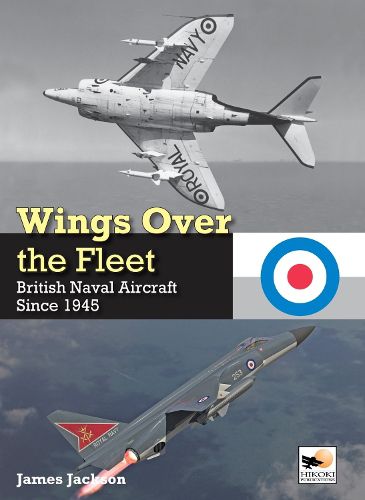Readings Newsletter
Become a Readings Member to make your shopping experience even easier.
Sign in or sign up for free!
You’re not far away from qualifying for FREE standard shipping within Australia
You’ve qualified for FREE standard shipping within Australia
The cart is loading…






The Royal Navy emerged from the Second World War with the second largest fleet of aircraft carriers in the world and a year later had achieved the world's first landing and take-off by a jet-powered aircraft from an aircraft carrier. The traditional roles of reconnaissance, aerial defence of the fleet and attack were joined by anti-submarine warfare (ASW) capabilities. Technological advances in jet propulsion and helicopters offered new tactical possibilities, as well as new practical problems to be overcome to enable their operation from carriers.
From the early 1950s the Fleet Air Arm operated a wide range of aircraft, from fighter-bombers, such as the Hawker Sea Hawk, to fully fledged nuclear-armed Blackburn Buccaneers and all-weather fighters like the de Havilland Sea Vixen and McDonnell Douglas F-4K Phantom. Westland's family of anti-submarine helicopters, the Wasp, Wessex, Sea King and Lynx operated from a wide range of ships, ranging from small frigates to carrier decks. Defence cutbacks that saw the retirement of the fleet carriers and the transfer of the Phantoms and Buccaneers in 1978, but the British Aerospace Sea Harrier operating from smaller anti-submarine carriers maintained the Navy's fixed-wing combat capability, this being memorably demonstrated in the South Atlantic in 1982. Today, the Royal Navy operates two modern carriers and shares the aviation commitment with the Royal Air Force, flying the most modern fighter in the world, the vertical take-off and landing capable Lockheed Martin F-35B Lightning.
Wings Over the Fleet describes the evolution and development of the Royal Navy's frontline aircraft from the late 1940s to the present day. All the major types are covered, from all-weather fighters, interceptors, strike aircraft, anti-submarine helicopters and airborne early warning aircraft. The planning and requirements behind the aircraft such as the Sea Hawk, Sea Vixen, Buccaneer, Gannet, Wasp, Sea King and Sea Harrier are examined, as are many design studies and proposals that remained on the drawing board. Guided missiles during the post-war period and the evolution of the Royal Navy's aircraft carriers and the new technologies required to operate jet aircraft from ships are also analysed.
$9.00 standard shipping within Australia
FREE standard shipping within Australia for orders over $100.00
Express & International shipping calculated at checkout
The Royal Navy emerged from the Second World War with the second largest fleet of aircraft carriers in the world and a year later had achieved the world's first landing and take-off by a jet-powered aircraft from an aircraft carrier. The traditional roles of reconnaissance, aerial defence of the fleet and attack were joined by anti-submarine warfare (ASW) capabilities. Technological advances in jet propulsion and helicopters offered new tactical possibilities, as well as new practical problems to be overcome to enable their operation from carriers.
From the early 1950s the Fleet Air Arm operated a wide range of aircraft, from fighter-bombers, such as the Hawker Sea Hawk, to fully fledged nuclear-armed Blackburn Buccaneers and all-weather fighters like the de Havilland Sea Vixen and McDonnell Douglas F-4K Phantom. Westland's family of anti-submarine helicopters, the Wasp, Wessex, Sea King and Lynx operated from a wide range of ships, ranging from small frigates to carrier decks. Defence cutbacks that saw the retirement of the fleet carriers and the transfer of the Phantoms and Buccaneers in 1978, but the British Aerospace Sea Harrier operating from smaller anti-submarine carriers maintained the Navy's fixed-wing combat capability, this being memorably demonstrated in the South Atlantic in 1982. Today, the Royal Navy operates two modern carriers and shares the aviation commitment with the Royal Air Force, flying the most modern fighter in the world, the vertical take-off and landing capable Lockheed Martin F-35B Lightning.
Wings Over the Fleet describes the evolution and development of the Royal Navy's frontline aircraft from the late 1940s to the present day. All the major types are covered, from all-weather fighters, interceptors, strike aircraft, anti-submarine helicopters and airborne early warning aircraft. The planning and requirements behind the aircraft such as the Sea Hawk, Sea Vixen, Buccaneer, Gannet, Wasp, Sea King and Sea Harrier are examined, as are many design studies and proposals that remained on the drawing board. Guided missiles during the post-war period and the evolution of the Royal Navy's aircraft carriers and the new technologies required to operate jet aircraft from ships are also analysed.